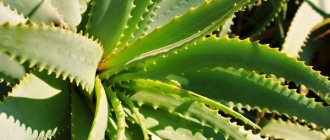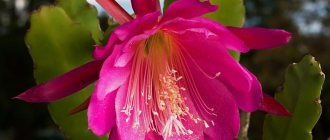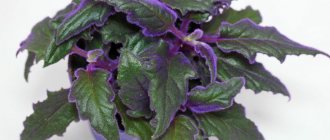Epiphyllum or phyllocactus is a genus of epiphytic plants from the Cactus family. Central America is considered the birthplace of the plant. There are about 20 species of epiphyllum that grow in the tropics and subtropics. This cactus was discovered by Adrian Haworth in 1812. The name of the culture is translated from the Greek words “επι” (top) and “φυλλον” (leaf). It has long, fleshy stems that many people mistake for leaves. And the flowers at the edges are also modified stems. In this regard, there is reason to classify epiphyllum as a leaf cactus.
This plant is very popular for home growing. Despite its tropical origin, phyllocactus has adapted well to indoor conditions. But in order to ensure its active growth and, most importantly, flowering, it is necessary to fulfill the mandatory points - compliance with the temperature regime, proper watering and fertilizing.
What are epiphytic cacti and what are their features?
These varieties of succulents are members of the cactus family (Cactaceae), native to the tropical forests of South and Central America, at altitudes ranging from 900 to 1500 m. These rainforest cacti get their name epiphytic because they grow on other plants (usually trees or shrubs). , although they are not parasites. Unlike most cacti, which live in arid desert conditions, epiphytic cacti growing in tropical forests can receive up to 400 cm of rainfall annually.
Most cacti in this group grow among fallen leaves high on tree branches in the rainforest. They get water from the air and nutrients from rotted leaves and forest organic matter. With their roots, they are fixed in the forks of tree branches, where organic remains decompose. This light, loose medium allows water and oxygen to reach plant roots, which absorb water and dissolved nutrients. Some varieties of epiphytes grow on rocks and have hard roots in the ground (lithophytes).
Epiphytic cacti are a wonderful collection of leaf succulents with some of the most unexpected and exceptional features anyone who purchases this plant species will encounter.
Possible difficulties
If not maintained properly, epiphyllum suffers from fungal diseases (black rot, anthracnose, fusarium, leaf rust). All these diseases are characterized by slower growth, the appearance of weeping spots on the leaves and trunk of various colors, as well as an unpleasant, putrid odor. It is necessary to replant the diseased plant, trim off the damaged areas and treat them with crushed charcoal. Fungicide is also sprayed.
The most common parasites for epiphyllum are spider mites, aphids, scale insects and mealybugs. They are combated by bathing and treating with insecticides (Confidor, Mospilan, Aktara, Biotlin).
Disocactus
The genus Disocactus (obsolete Aporocactus) belongs to the plant tribe Hylocereeae and grows as forest leaf cacti - epiphytes (on trees) or lithophytes (on rock formations). Native to parts of Mexico, Central America and the Caribbean, this plant is a challenge for the experienced gardener.
Growing Disocactus species can be challenging, but once you learn how to care for your succulent when your plant reaches maturity, you'll enjoy the magic of these fragrant, night-time bloomers. Flowers are formed along the entire length of the stems or at the growing ends of the cacti (depending on the species).
Disocactus flagelliformis
Disocactus or Aporocactus whip-shaped has a rounded stem structure, with thick and hanging stems reaching a length of 1 m, and almost 2 cm in width.
These bright green stems are covered with clusters of indistinct tufts of needles, each composed of thin orange spines. The flowers are large and beautiful, appearing en masse along the stems in late spring - early summer.
Reproduction of epiphyllum
The main method of propagation of epiphyllums remains cuttings. This plant is practically not grown from seeds at home.
Epiphyllum cuttings are cut from strong, young and intact shoots. Typically, the stems are cut into fragments of 4-6 cm, treating the cuts with charcoal and leaving them to dry for 2-3 days until a dense film forms at the cut site. Keeping in a growth stimulator speeds up the rooting process.
The cuttings are rooted in sand, preferably coarse sand or river sand, pre-calcined, under a cap or film, keeping the soil moisture light and stable. If there is a large amount of planting material, rooting can be carried out in water, deepening the lower sections by 1-1.5 cm.
Epiphytic cacti of the genus Epiphyllum (Epiphyllum)
There are 19 species in this genus, all of which exist as epiphytes with thick, wide and flattened stems, mostly with wavy, lobed edges. Epiphyllum cacti are characterized by large, impressive flowers. In the last few years, the plants have undergone extensive hybridization to produce a variety of flowers in varying shades.
Epiphyllum is an easy-to-grow and fast-growing genus of succulent that enjoys moist, humus-rich soil and partial shade.
Epiphyllum serrated
The beautiful flowers of Epiphyllum crenatum grow from late spring to early summer. The flower itself is cup-shaped with long, creamy-white inner tepals and pale yellow stamens.
In total, the flower can reach 29 cm in length and up to 20 cm in width, has a strong aroma and is nocturnal, opening at night to attract insects for pollination. The flowers will remain open for several days.
Cactus Epiphyllum acupetallus
Epiphyllum oxypetalum is widely known as the only Epiphyllum species to be widely used for cross-pollination with other genera, such as Disocactus, in an attempt to develop a range of colored hybrids.
Epiphyllum acupetallus
The flower color of Epiphyllum hybrid varieties varies from white to light yellow and orange, and sometimes dark amber hybrids can be found.
Features of seasonal care
During the year, the plant experiences periods of active growth and relative dormancy. In autumn, all vital processes are slowed down, and during the winter the flower rests. During this period, it is advisable to provide him with cool air (+10..15°C). There is no need to additionally highlight the plant. But if it winters in a warm room, you will have to turn on the backlight in the evening. Water the flower 1-2 times a month. You need to resume abundant watering in the spring, gradually increasing it more often. There is no need to feed the cactus in winter.
Epiphytes Hylocereus
The unusual leaf cacti of the genus Hylocereus are among the largest of the epiphytic cacti. These large, climbing semi-epiphytes native to Central and North America have fleshy, articulated stems with aerial roots. They use their roots to cling to trees and shrubs in dry and open forested areas.
Their triangular stems grow to an impressive 5m in length, allowing them to reach a total height of up to 10m. The fruits of the Hylocereus species are completely edible. They contain white pulp studded with hundreds of black seeds. They are also called “dragon fruit”. These exotic-looking fruits are now grown for juice, wine and liquor and eaten fresh in many countries around the world.
Hylocereus wavy or Hylocereus sinuous (Hylocereus undatus)
This ampelous cactus is the most cultivated of all species of the genus Hylocereus. Dark-colored spines grow only on the mature branches of this climbing cactus, and gorgeous flowers bloom at the ends of the branches.
In summer, the ripe buds bloom and a white, bell-shaped flower appears. These powerful and fragrant flowers reach 35 cm in length and up to 30 cm in diameter, opening at dusk for one night only.
Diseases and pests, control methods
With excessive soil moisture and hypothermia, the epiphyllum can be affected by fungal infections:
- black rot;
- fusarium;
- rust.
To save the phyllocactus, you need to remove it from the pot and remove the damaged areas. Sprinkle the sections with activated carbon, and the entire plant with a fungicide solution (Topaz, Fitosporin). To avoid re-infection, it is necessary to regulate watering and temperature conditions.
Epiphyllum pests:
- mealybug;
- scale insect;
- spider mite
At the initial stage of damage, you can spray the bush with an alcohol or soap solution. If there are a lot of pests, it is better to use insecticides:
- Aktara;
- Aktellik;
- Karbofos;
- Fitoverm;
- Decis.
Epiphytes of the genus Hatiora
The next genus of epiphytic cacti is Hatiora, native to the tropical forests of southeastern Brazil. In nature, they grow on trees and sometimes on rocks. All plants of this genus have succulent stems that grow straight or trailing, without thorns.
This genus is divided into two subgenera - Hatiora and Rhipsalidopsis, each of which has the following distinctive characteristics and plant forms:
- Plants of the subgenus Hatiora typically have a woody base, a cylindrical segmented stem structure, and an erect growth habit. The flowers of this subgenus are usually quite small and come in red, orange and pink colors.
- Plants of the subgenus Rhipsalidopsis have a more flattened structure in the form of segments of a more pendulous stem. The flowers are much larger in size and are red or pink in color. There is only one exception, Hatiora epiphylloides with small yellow flowers.
Hatiora gaertneri
The well known Hatiora gaertneri, also called "Easter cactus" in the west. One of the most famous epiphytic cacti, which even amateur gardeners know about. This plant belongs to the tribe Rhipsalideae.
It has flattened, segmented, pendulous stems with flowers appearing from March to April. These wonderful tube-shaped flowers grow at each end of the stem and vary in shades of red or pink and have lighter stamens. The flowering period can be extended if suitable conditions are created - more water and a cool evening temperature of about 7-8 degrees.
Hatiora herminiae
Another representative of epiphytes is Hatiora herminiae, a representative of the subgenus Hatiora. Erect, with a cylindrical segmented stem structure.
Its unique and mostly solitary flowers grow again at the top of the stem, a beautiful deep pink color, each growing to approximately 2.5cm in length. The fruits of Hatiora herminiae reach 8 mm in length and are olive green in color.
These types of tree cacti are relatively easy to grow, preferring environments with high humidity and cooler temperatures than most other tropical plants.
Home care
Phyllocactus is a non-capricious plant. But in order not to destroy it and ensure flowering, you need to adhere to some rules of agricultural technology.
Location and lighting
For normal development, epiphyllum requires a lot of light. But he must be absent-minded. Windows facing east or west are suitable for placing the cactus. On the northern part of the room the plant will bloom poorly or not bloom at all. On a south-facing window, it will need shading from the midday sun. In summer, you can take the phyllocactus outside. But choose a place where there are no drafts and scorching sun.
Choosing a pot
Standard containers are suitable for this plant. But it is preferable to choose shallow ones with a wide diameter. The roots should not be crowded; there should be 3-4 cm of free space between them and the walls of the pot. If there is too much free space, this will lead to acidification of the soil and rotting of the roots. The pot material must be breathable so that the plant's roots can breathe. Ceramic or clay is better.
Soil and drainage
Epiphyllum grows normally in nutritious soil with a slightly acidic pH of 5-6.
You can buy ready-made soil mixture for cacti or prepare the soil yourself:
- leaf soil (4);
- fibrous turf (1);
- charcoal (1);
- sand (1).
You can mix rotted leaf soil (4) with coarse sand (1).
Important! The presence of lime in the soil for epiphyllum is not allowed. To prevent moisture stagnation, the bottom of the pot must be provided with good drainage (expanded clay, pebbles) before planting.
Planting and transplanting
The roots of leaf cactus are superficial and rather poorly developed. Therefore, it is replanted once every 4-5 years, sometimes less often. The best time is after flowering has ended. If the bush has grown greatly, you can simultaneously divide it and rejuvenate the plant.
Transplant algorithm:
- Prepare a new pot of suitable size, fill it 1/3 with drainage.
- The plant is not watered for 2-3 days so that it can be easily removed from the container along with the soil.
- Carefully remove it without touching the roots. If possible, remove some of the old soil. If there is damage to the roots, sprinkle them with charcoal.
- Place the phyllocactus in the center of the new pot. Fill the voids with fresh soil, do not compact them.
- Place the flowerpot in a shaded, cool place for 5-7 days so that the plant takes root faster.
- Water it only after the end of quarantine.
Video - instructions for transplanting Epiphyllum:
Temperature
In the spring-summer period, epiphyllum is comfortable at +20..25°C. Since November he has experienced relative peace. Therefore, it is better to place the plant pot in a room with a temperature of +10..15°C.
Watering and air humidity
Phyllocactus requires watering more often than other representatives of Cacti. In summer, the soil should always remain moderately moist. The main thing is to prevent moisture stagnation. During the winter dormancy period, watering should be reduced to a minimum. But don’t let the earthen soil dry out completely. On average, a flower is watered 2 times a week in summer, and 1-2 times a month in winter (if wintering is cool). Use warm, well-settled water.
As a representative of the tropics, epiphyllum loves moisture. Therefore, it responds well to spraying in the summer. Sometimes its leaves can be washed from dust under a warm shower. During cool wintering, spraying is not carried out.
Feeding and fertilizers
Fertilize the crop twice a month during the growing season. For this purpose, compositions for cacti and succulents are used. During budding, feed the flower with a solution of mullein (1:4). After flowering has ended, it can also be applied until the dormant period begins. You can alternate mullein infusion with nitrogen fertilizers. In winter, phyllocactus does not need additional nutrition.
How to make it bloom
For normal flowering, you need to provide the plant with proper care. As soon as the formation of buds begins, it is forbidden not only to rearrange the flowerpot, but even to turn it. Otherwise all the buds will fall off. The flowers bloom one at a time and each blooms for about a week.
There are times when the plant does not bloom in due time. There may be several reasons: poor lighting, excessive watering in winter, warm wintering, excess nitrogen.
To correct the situation, measures must be taken:
- Avoid nitrogen fertilizers for a while.
- From November to February, provide cool conditions.
- Place the culture under bright, diffused light.
Some gardeners prefer to awaken the epiphyllum in the spring with a warm shower. Soon it will have flower stalks.
Trimming
To maintain the decorative appearance of the bush, it must be pruned periodically. Epiphyllium flowers grow between the notches of the shoots. The next season they no longer produce flowers. Therefore, it is better to remove them after 2-3 years. When pruning, keep in mind that flowers appear on last year's shoots, and not those grown this season.
Epiphytic cacti of the genus Lepismium
This epiphytic cactus genus Lepismium is native to the lowland tropics and moist montane forests of South America. The culture has about a dozen varieties. Let's look at the two most popular types.
Lepismium cruciform
Lepismium cruciforme is more commonly found in cactus collections consisting of long, twisting succulent stems, each armed with tiny, furry clusters of white spines.
In bright sun, the plant changes color from a natural green shade to a dark pink-burgundy. The stems are very diverse, have a polygonal structure and reach 50 cm in length and 2 cm in width. The flowers are borne along the long, spiny edges of the stem and are quite small and vary in color from creamy white to yellow-pink.
Lepismium floribundum
A recently discovered species with much larger and more fragrant flowers than other members of the genus.
Its dark green, curved and flat stems begin to droop over time, reaching several meters in length. Along the stems are many fragrant, pale pink, bell-shaped flowers. A cold-resistant specimen of a plant with a beautiful bend and a high growth rate.
Ampelous cacti of the genus Selenicereus
More commonly known as the Queen of the Night, it is a genus of epiphytes, lithophytes, and terrestrial plants native to most American rainforests. There are a couple dozen species in the genus, all with a similar climbing stem shape. Their shape varies from flat to thin and ribbed, each with many knobby areoles and aerial roots that help them climb trees, shrubs and rocks.
Selenicereus testudo
Ampelous cacti of this species produce funnel-shaped, fragrant, white flowers that open at dusk for one night only.
Selenicereus grandiflorus
Photo of the ampelous cactus Selenicereus grandiflora (flickr.com)
The most famous variety of Selenicereus, also known as the “queen of the night.” This species is very rarely grown, although it is known throughout the world for its large and shiny white flowers. Each flower reaches 20.32 cm in length and exudes a sweet night scent.
Pfeiffera monacantha
A relatively compact and slow-growing ampelous cactus, native to Argentina and Bolivia, another example of a plant belonging to the tribe Rhipsalideae. The young plant has an erect and spiny stem, almost triangular in shape. Over time, the flower takes on a flatter, more branched, and more pendulous shape.
These linear, oblong branches can reach 45 cm in length. Each areole on the stem produces small, tubular, waxy orange flowers along the length of the flattened branches. Pfeiffera monacantha is a prolific flowering unusual epiphyte that requires little care, warmth and partial shade.
Like any other organism, epiphytic cacti play a role in nutrient cycling, increasing the diversity and biomass of the ecosystem in which they live.
The article used materials from the site worldofsucculents.com
Emerging problems
Various cactus diseases can also arise from improper plant maintenance:
- The stems become pale and wrinkled - weak watering, heat and stagnant air.
- Yellow dry spots on the stem - exposure to direct sunlight.
- Rotten roots and softened stems – waterlogging and poor drainage system.
ADVICE! To prevent various diseases of Phyllocactus, it is necessary to strictly follow the rules and recommendations for care.
The buds fall off, the tips of the stems dry out, and a pattern of light spots appears on them - a viral mosaic of Epiphyllum. The plant is quarantined with removal of affected areas and chemical treatment. In case of severe infection, the specimen is destroyed.











